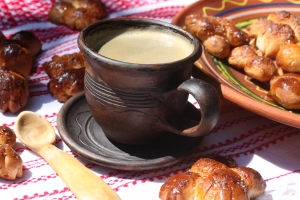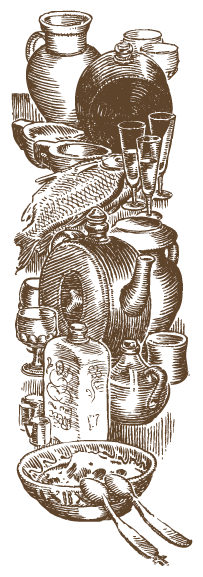The land of Ethiopia not without reason is considered to be ancestors’ fatherland of coffee. Thanks to arab nomads and merchants coffee became popular in the countries of Middle East. The coffee came to Bosporus and Dardanelles channels thanks to 22 years old Turkish sultan Mehmed II who as a conqueror entered the gates of Tzargorod – Constantinople. It happened on the 29th of May, 1453. To storm Constantinople the young sultan brought more than 100 000 soldiers and a big
navy, counted with 100 military galley-katorga, that is naval vessels.
Beyond any dispute the most favoutite drink of Turkish equestrians and sailors was coffee. Thus, thanks to the young and energetic sultan Mehmed II coffee appeared
on the eastern coast of Europe. The journey of this drink via different European routes lasted for several centuries. And it happened with the help of the restless sultan Mehmed II. When he was 44 years old, that is in 1475, his faithful spahis and janissaries captured not only one of the most powerful trading centres of Eastern Europe of those times which was Caffa (the city of Feodosia) but also other cities of the southern Crimea including Mangup (the capital of the principality of Theodore). So, in the Crimea the Turkish Province (sandzak of Caffa) was founded which lately joined captured cities of all Nothern Prychornomorya (geographical parts of contemporary Crimea) and the coast of the Sea of Azov. Since that time vassals of Turkish sultan (Crimean tartars) systematically started capturing Ukrainian, Lithuanian and Polish lands devastating them with cruel bloody raids. The main aim of these raids was capturing of people. This chasing of boys and girls starting from 5 years old, mature strong and healthy men and women was called by the soldiers of horde “Yassa” or “Yassu” which meant “triumphal spoil”. This human spoil was later resold on all the slave markets of Asia Minor and North Africa up to Morocco. These aggressive actions of hordes of Crimean tartars caused the appearance of a new powerful military force that is of orthodox knight order of Zaporozhian Cossacks. In 1492 the Crimean khan Meñli Giray expressed his complaints on Cossacks in his letter to Grand Duke of Lithuania Alexander where he was writing about Cossacks of Kyiv and Cherkasy oblasts who captured Ottoman military galley with prisoners nearby the town of Tyagynya. The fortress of Tyagynya is turkish fortress of that time that was placed on Dniester river (nowadays it’s the city of Bender in Moldova). In fact our ancestors who were Cossacks came down by the river Dnipro in boats from Kyiv to Cherkasy, sailed across the Black Sea, went up the Dniester river and seized the powerful military ship in front of the eyes of Turkish garrison of Tyagynya fortess.
Later a famous historian Mykhailo Hrushevskyi wrote: “It was the first written reminiscence of Zaporozhian Cossacks”. In a while so called cultural exchange on European lands of Ukraine among Zaporozhian Cossacks and Turkish Ottamans was getting more intense and vast. Getting “Cossack bread”, that is military spoil, Zaporozian Cossacks liberated orthodox prisoners from the slavery and ruined the cities and towns all over the coast of the Black sea. Our ancestors Zaporozhian Cossacks used to take long and short fields by the sea two and three times a year repeatedly burning Constantinople and its suburbs. As one of the Cossack ballades said: “… Varna has been famous from remote times, but Cossacks are even more glorious…”. However sea battles were not always successful for Cossacks. Failures could happen when Turks managed to mobilize their whole marine or when the storm or tempest pushed Cossack boats “chaikas” on the Turkish coast. So, thousands of our ancestors could be captured and in such an unpleasant way they got familiar with the custom of having coffee in Ottoman Empire.
Also there known historical evidences when Cossack spies were sent from “the nest of freedom” (Zaporozhian Sich) disguised as folk singers kobzars-lyrists, pilgrims to holy lands, ambassadors and merchants “tchoomak” (travelers) to Istanbul and other cities where there were slaves’ trading squares. The spies aimed at redeeming of Christian captives and diplomatic negotiating. Sometimes Cossack ambassadors were made to stay in Istanbul for months waiting for positive resolution. They were meeting with Turkish officials who treated Cossacks with coffee.
It is known that in the hetman’s residence which was based in Subotiv Bohdan Khmelnytskyi treated his foreign ambassadors from Western Europe and Muscovy with the traditional Turkish drink coffee. Being a young warrior Bohdan Khmelnytskyi in 1620 near Tsetsora was captured by Turks where he stayed for 2 years until his mother saved money for ransom. Turks treated him well according to his status, they understood that he could be very beneficial for them. So the young nobleman Bohdan Khmelnytskyi not only learnt Turkish language but also got acquainted with customs of drinking of tonic beverage that is coffee.
In medieval Ukraine the cup for this fragrant drink was called “filizhanka”. In particular the Great Ukrainian Ivan Kotlyarevskyi in his immortal work “Eneida” mentioned the existence of “filizhankas”…
After death of Bohdan Khmelnytskyi a tragic period in Ukrainian history started. This period is called in historical references as a “Ruin” that is a civil war between our leaders colonels who after the death of Bohdan Khmelnytskyi started fighting and trying to share hetman’s mace and the country of Ukraine into two, three and even four pieces. As the result of these conflicts the Turkish forces were standing in garrisons in Chyhyryn, Cherkasy, Kaniv, Korsun, Uman and all over Podillia including Nemyriv, Bratslav and Kamianets-Podilskyi.
It’s obvious that Turkish garrisons not only transformed our churches into mosques but also during several dozens of years lived peacefully with locals who under the circumstances were getting familiar with the customs of having coffee.
It is known also one more historical fact. The eminent colonel from Fastiv (the town of Fastiv is situated in 50 km towards the south of Kyiv) Semen Palii (being also Cossack kharakternyk (sorcerer) according to the evidence of Hetman Ivan Mazepa) not only knew Turkish custom of having coffee but also encourage Cossacks of his regiment to drink this tonic fragrant beverage. The experienced Zaporozhian Cossack Semen Palii used to say his Cossacks that: “… having coffee the Ukrainian warriors will be able to understand Turkish mind, manoeuvres and military intentions…”. Even though the Cossacks of Semen Palii’s garrison created their own recipe of having coffee – adding some milk and honey. Such a coffee unlike Turkish bitter one tasted better to Zaporozhian Cossacks.
During several centuries Ukrainian Cossacks led long and short wars on land and sea against the active army of Ottoman Empire. So they often received as trophies the carriages filled with different foodstuffs, accoutrements and military supplies. Among all these things they happened to find carriages loaded with sacks filled with coffee. Obviously Cossacks knew about the drink that Turks used to make of coffee beans and that’s why didn’t throw it away. Exactly such an incident happened in 1683 near Vienna when intelligent Cossack Yurii Kulchytskyi asked for his reward several hundreds of sacks of coffee beans that remained in a camp of defeated Turkish army. European noblemen as well as regular soldiers didn’t know about the use of the coffee beans in sacks and considered them as unknown waste.
It’s well known that the first coffee shop in Europe in the capital of Austria Vienna was opened by Ukrainian Cossack Yurii Kulchytskyi on the 13th of August, 1684. Thanks to the efforts of Cossack Yurii Kulchytskyi coffee became one of the most fashionable beverages of numerous restaurants in Vienna, Budapest, Prague, Munich, Amsterdam, London and other big European cities of that time.
Even though our ancestors began to drink coffee 100 or even 150 years before Europeans started doing it this tradition was forgotten in the central Ukraine. This unpleasantness happened not because Ukrainians lost their love for coffee but because of the efforts of another Asian Empire the capital of which was located in Petersburg. The Empire of Moscow destroyed “the nest of the golden freedom” Zaporozhian Sich and changed Zaporozhian knights into slaves, took all the rights as well as the possibility to taste coffee. After becoming serfs the Ukrainians lost not only coffee as a drink but also the word “filizhanka” (the cup which was used for having coffee in the Central Ukraine).
As a summary we may surely state that even though coffee was brought to Europe by Turks it couldn’t become so popular without the assistance of Zaporozhian Cossacks.

